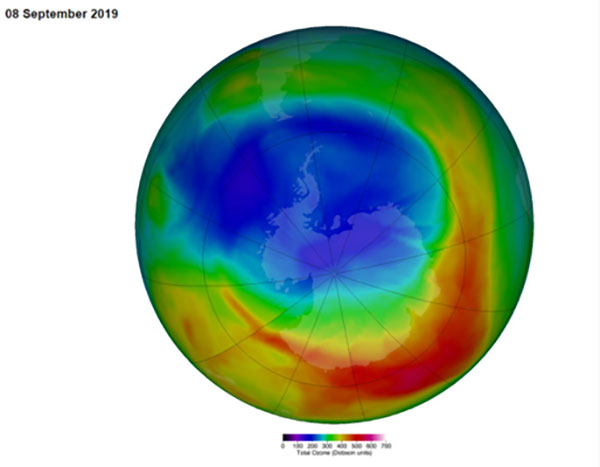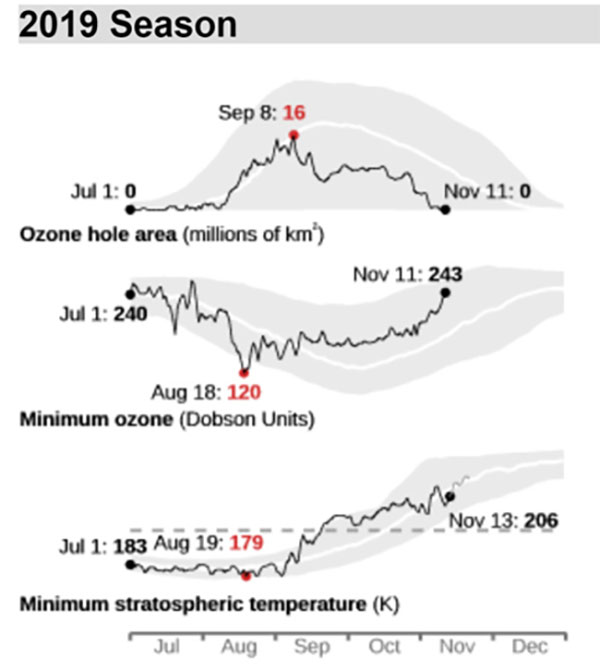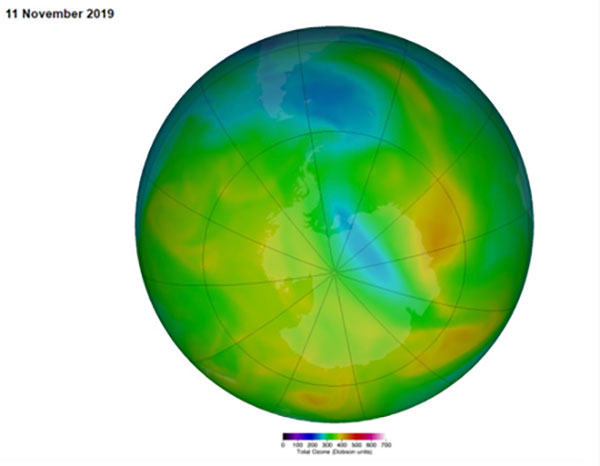[Sources: ESA | NASA Ozone Watch] Seeing the ozone hole permanently vanish won’t be for another decade, but for 2019, it has sealed itself up in near-record time. Just a month or so ago, the 2019 Antarctic ozone hole was declared the smallest seen since it was first discovered back in 1985.
Now, data from NASA Ozone Watch is showing that the ozone hole has completely closed up as of November 11 – the earliest it has done so since 2002.
The Antarctic ozone hole has formed every year since 1980. Each year, as the south pole plunges into the darkness of the southern winter, the bone-chilling cold causes the south polar vortex to tighten up and concentrate its flow around the pole. In this flow, ozone-destroying chemicals known as chlorofluorocarbons (CFCs) become concentrated in the polar stratosphere. When the sunlight finally touches that part of the atmosphere again, in late July, it sets off a flurry of chemical reactions that break down ozone. The result is a wide hole in the protective ozone layer over the Antarctic continent.

The reactions between CFCs and ozone require not only sunlight but the presence of polar stratospheric clouds. It’s the water droplets that form these clouds, which are essentially the focal point of these reactions. So, fewer polar stratospheric clouds, fewer ozone-destroying CFC reactions. No polar stratospheric clouds? No ozone-destroying CFC reactions.
The weather comes into play here because for polar stratospheric clouds to form, it needs to be extremely cold, down to -78°C. On average, temperatures in the polar stratosphere drop below that point around mid-May and stay that cold until mid-October, bottoming out at around -90°C in early August.

In 2019, temperatures in the south polar stratosphere started off fairly average and reached down to -94°C by the beginning of September. Then, over the course of just a few days, temperatures rose to -80°C – just a few degrees below the temperature needed to form polar stratospheric clouds. By the end of the month, they’d risen again to -73°C. That’s 12 degrees warmer than normal for that time of year.
As a result, the spread of polar stratospheric clouds was stifled in early September, limiting the number of ozone-destroying reactions. This led to the 2019 ozone hole becoming the smallest we’ve seen since 1985.
The second temperature spike then caused those clouds that had formed to completely dissipate by the end of September. Due to this, ozone destruction came to a complete halt, and ozone levels began to build back, roughly a month earlier than normal.
Thus, by November 11, the hole had completely resealed itself.

While satellite records are clearly showing a ‘healing’ trend for the annual ozone hole, this year is definitely an anomaly due to the warmer stratospheric temperatures.
A similar pattern of temperatures was seen in 2002. That year, the ozone hole closed back up by November 7, which remains the earliest the hole had closed since 1988. Both times this has happened, the peculiar spike in temperatures during the latter half of the season cut off ozone destruction and allowed the hole to repair itself in record and near-record time.
Since it is unlikely that we’ll see this pattern of a warmer stratosphere again next year, ozone scientists are already predicting that the 2020 ozone hole will likely be larger, probably in line with what we saw in 2018.
Scott Sutherland Meteorologist/Science Writer
Sources: ESA | NASA Ozone Watch
November 2019


